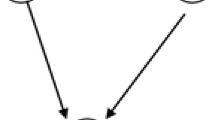... it must happen, in an eternal Duration, that every possible Order or Position must be try'd an infinite Number of times. This World, therefore, with all its Events, even the most minute, has before been produc'd and destroy'd, and will again be produc'd and destroy'd, without any Bounds and Limitations. Noone, who has a Conception of the Powers of Infinite, in comparison of finite, will ever scruple this Determination...
Suppose, (for we shall endeavor to vary the Expression) that Matter were thrown into any Position, by a blind, unguided Force; it is evident that this first Position must in all Probability be the most confus'd and most disorderly imaginable,...
Thus the Universe goes on for many Ages in a continu'd succession of Chaos and Disorder. But is it not possible that it may settle at last,... so as to preserve an Uniformity of Appearance, amidst the continual Motion and Fluctuation of its Parts?
Philo, in Hume'sDialogues, pp. 209 and 211
Abstract
In the the passage just quoted from theDialogues concerning Natural Religion, David Hume developed a thought-experiment that contravened his better-known views about “chance” expressed in hisTreatise and firstEnquiry.
For among other consequences of the ‘eternal-recurrence’ hypothesis Philo proposes in this passage, it may turn out that what the vulgar call cause is nothing but a secret and concealed chance.
(In this sentence, I have simply reversed “cause” and “chance” in a well-known passage fromHume's Treatise, p. 130).
In the first eight sections of this essay, I develop one topological and model-theoretic analogue of Hume's thought-experiment, in which ‘most’ (‘A-generic’) modelsM of a ‘scientific’ theoryU are both ‘eternally recurrent’ and topologically random (in a sense which will be made precise), even though they are ‘inductively’ defined, via a step-by-step (‘empirical’?) procedure that Hume might have been inclined to endorse.
The last aspect of this model-theoretic thought-experiment also serves to distinguish it from simpler measure-theoretic prototypes that are known to follow from Kolmogorov's Zero-One Law (cf. the Introduction, 5.2, 6.1 and 6.7 below).
In the last three sections, I will argue more informally
-
(1)
that the metamathematical thought-experiments just mentioned do have a genuine metaphysical relevance, and that this relevance is predominantly skeptical in its implications;
-
(2)
that such ‘nonstandard’ instances of semantic underdetermination and ‘pathology’ seem to be the metatheoretic rule rather than the exception; and therefore,
-
(3)
that metamathematical and metatheoretic ‘malign-genius’ arguments are quite coherent, contrary (e.g.) to assertions such as that of Putnam (1980), pp. 7–8.
In the essay's conclusion, finally, I assimilate (2) and (3) to the familiar datum that ‘simplicity’, rather than ‘pathology’, has more often than not turned out to be an anomalous ‘special case’ in the historical development of scientific and mathematical ontology.
Similar content being viewed by others
References
Barwise, K. and S. Feferman: 1985,Model-theoretic Logics, Springer, Berlin.
Barwise, K. and A. Robinson: 1970, ‘Completing Theories by Forcing’,Annal of Mathematical Logic 2(2), 119–42.
Bell, J. and M. Machover: 1977,A Course in Mathematical Logic, North Holland, Amsterdam.
Bell, J. and A. Slomson, A. 1969,Models and Ultraproducts, North Holland, Amsterdam.
Berkeley, G.: 1975,Philosophical Works, M. Ayers (ed.), Dent, London.
Boolos, G.: 1989, ‘A New Proof of the Gödel Incompleteness Theorem’,Notices of the American Mathematical Society 36, 388–90.
Boos, W.: 1983, ‘Limits of Inquiry’,Erkenntnis 20, 157–94.
Bowen, K.: 1979,Model Theory for Modal Logic, D. Reidel, Dordrecht.
Chaitin, G.: 1988,Algorithmic Information Theory, Cambridge University Press, Cambridge.
Hirschfeld, J. and W. Wheeler: 1975,Forcing, Arithmetic, Division Rings, Springer, Berlin.
Hume, D.: 1976,Dialogues Concerning Natural Religion, J. Price (ed.), Clarendon, Oxford.
Hume, D.: 1975,Enquiries Concerning Human Understanding and Concerning the Principles of Morals, P. Nidditch (ed.), Clarendon, Oxford.
Hume, D.: 1978,A Treatise of Human Nature, P. Nidditch (ed.), Clarendon, Oxford.
Husserl, E.: 1954,Die Krisis der Europäischen Wissenschaften und die Transzendentale Phänomenologie, Nijhoff, Haag.
Jech, T.: 1954,Set Theory, Academic Press, New York.
Keisler, H.: 1971,Model Theory for Infinitary Logic, North Holland, Amsterdam.
Keisler, H.: 1973, ‘Forcing and the Omitting Types Theorem’, in M. Morley (ed.),Studies in Model Theory, Mathematical Association of America, Buffalo, pp. 96–133.
Kunen, K.: 1984, ‘Random and Cohen Reals’, in K. Kunen and J. Vaughan (eds.),Handbook of Set-Theoretic Topology, North Holland, Amsterdam, pp. 887–911.
Lee, V. and M. Nadel: 1975, ‘On the Number of Generic Models’,Fundamenta Mathematicae 90, 105–14.
Lee, V. and M. Nadel: 1977, ‘Remarks on Generic Models’,Fundamenta Mathematicae 95, 73–84.
Losee, J.: 1980,A Historical Introduction to the Philosophy of Science, Oxford University Press, Oxford.
Mill, J.: 1974,A System of Logic Ratiocinative and Inductive, Toronto University Press, Toronto.
Monk, J.: 1976,Mathematical Logic, Springer, Berlin.
Oxtoby, J.: 1970,Measure and Category, Springer, Berlin.
Putnam, H.: 1980,Reason, Truth and History, Cambridge University Press, Cambridge.
Rasiowa, H. and R. Sikorski: 1970,The Mathematics of Metamathematics, third edition, Polish Scientific, Warszawa.
Rucker, R.: 1987,Mind Tools, Houghton Mifflin, Boston.
Shoenfield, J.: 1967,Mathematical Logic, Addison/Wesley, Reading.
Smorynski, C.: 1977, ‘The Incompleteness Theorems’, in J. Barwise (ed.),Handbook of Mathematical Logic, North Holland, Amsterdam, pp. 821–65.
van Dalen, D.: 1983,Logic and Structure, second edition, second corrected printing, Springer, Berlin.
Vesley, R.: 1989, Letter,Notices of the American Mathematical Society 36, 1352.
Author information
Authors and Affiliations
Rights and permissions
About this article
Cite this article
Boos, W. The world, the flesh and the argument from design. Synthese 101, 15–52 (1994). https://doi.org/10.1007/BF01063967
Issue Date:
DOI: https://doi.org/10.1007/BF01063967




